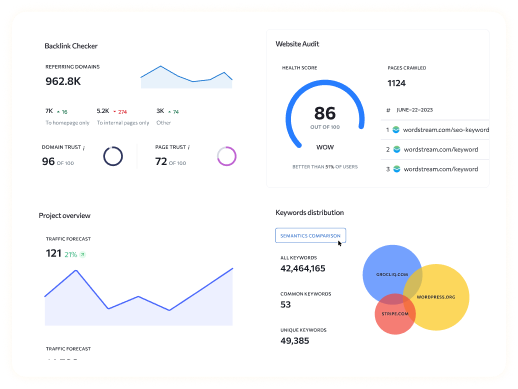If you’re aiming to enhance your Squarespace website’s performance and improve its Google rankings, you’re in the right place. A well-structured Squarespace SEO checklist is crucial to maximizing visibility, driving organic traffic, and ultimately boosting your site’s performance in search engine results. While Squarespace offers some built-in SEO features, it’s important to fine-tune your website’s SEO to reach its full potential.
This guide will walk you through a comprehensive Squarespace SEO checklist, helping you optimize everything from keyword research to content optimization and technical improvements. By following these steps, you can successfully increase your search engine ranking and ensure your website stands out in the competitive digital landscape of 2025. Let’s dive in and get your site to the top!
Why SEO Matters for Squarespace Websites
SEO is essential for making your Squarespace website visible to search engines and driving organic traffic to your pages. While Squarespace comes with several built-in SEO features, such as clean URLs and mobile responsiveness, it’s still vital to implement additional strategies to fully optimize your site.
For small businesses, blogs, and eCommerce websites, SEO is the key to standing out from the competition. Properly optimized Squarespace websites can see improvements in search engine rankings, attracting more visitors, and ultimately converting traffic into sales. A solid Squarespace SEO checklist helps ensure your site is ready to compete for top spots on Google.
Although Squarespace provides a great foundation for search engine indexing, users must optimize their content and implement more advanced SEO tactics for the best results.
Getting Started – Essential SEO Tools for Squarespace
Before diving deep into your Squarespace SEO checklist, it’s crucial to set up the tools necessary to track and analyze your site’s performance. These tools will give you insights into your website’s SEO health and guide you toward improvements.
Here are the top SEO tools to use for optimizing your Squarespace site:
- Google Search Console: This free tool provides valuable information about your website’s performance, including how it’s indexed by Google and which search queries lead to your site.
- Google Analytics: Use Google Analytics to track your site’s traffic, user behavior, and conversions. This tool is invaluable for measuring your SEO performance.
- Google Keyword Planner or Ahrefs: For keyword research, these tools are essential. They help you identify high-traffic keywords that are relevant to your site’s niche.
- Google Tag Manager: Easily manage tags for tracking without needing coding skills. Google Tag Manager simplifies the process of adding tracking codes to your Squarespace site.
- SEO Plugins (e.g., TinyIMG): Use SEO plugins like TinyIMG to compress and optimize your images. Faster page load times are important for both user experience and SEO.
Quick Tip: Set up these tools first, so you can track your progress as you follow the steps in your Squarespace SEO checklist.
Squarespace SEO Checklist – Step-by-Step Guide
1. Perform Comprehensive Keyword Research
Keyword research is the backbone of your Squarespace SEO checklist. By identifying the right keywords, you can ensure that your content ranks well for the terms your target audience is searching for. Here’s how to perform keyword research:
- Google Suggestions and Google Keyword Planner are great tools for finding keywords.
- Explore Related Searches on Google to uncover additional keyword ideas.
- Focus on long-tail keywords (e.g., “Squarespace SEO tips for beginners”) to target more specific search intent.
Quick Tip: Use a unique target keyword for each page or blog post to prevent keyword cannibalization and maximize rankings.
2. Optimize Your On-Page SEO
On-page SEO refers to the elements on your website that you can control. Optimizing these elements will ensure that Google and users can easily find, understand, and interact with your content.
Add Keywords to Key Areas
- Title Tag: Keep it under 60 characters and include the target keyword.
- Meta Description: Write a compelling description with keywords (150-160 characters).
- URLs: Use short, descriptive URLs (e.g., /squarespace-seo-checklist).
- Headings: Use a proper heading structure. Place your main keyword in the H1, and variations in H2 and H3.
Optimize Content
- Include target keywords naturally throughout the content.
- Use synonyms and LSI (Latent Semantic Indexing) keywords to add depth and improve keyword relevance.
- Ensure your content answers the search intent of users.
Optimize Images
- Resize and compress images to speed up page load times.
- Rename image files using descriptive keywords (e.g., squarespace-seo-checklist.jpg).
- Add alt text to improve accessibility and provide additional SEO value.
3. Improve Technical SEO
Technical SEO is essential for making sure that search engines can crawl, index, and render your Squarespace website properly. Follow these steps to improve your site’s technical SEO:
- Check for Site Speed and Mobile Friendliness: Use Google PageSpeed Insights to test your site’s speed and improve load times. Squarespace’s mobile responsiveness is built-in, but it’s important to ensure your content displays correctly on mobile devices.
- Enable SSL (HTTPS): Google prefers websites that are secure. Make sure your Squarespace site uses SSL encryption (HTTPS) to improve security and SEO.
- Submit XML Sitemap to Google: Squarespace automatically generates an XML sitemap for your website. Submit this to Google Search Console to make sure your pages are indexed.
- Fix Broken Links: Use tools like Screaming Frog or Ahrefs to find broken links and fix them. Broken links negatively impact both user experience and SEO.
4. Build High-Quality Backlinks
Backlinks are critical for boosting your Squarespace website’s authority. A strong backlink profile can significantly improve your site’s rankings. Here’s how to build high-quality backlinks:
- Guest blogging on relevant websites is an effective way to earn backlinks.
- Find unlinked mentions of your brand across the web and request that they add a backlink.
- Broken link building involves identifying broken links on other websites and offering your content as a replacement.
Quick Tip: Focus on acquiring backlinks from high-authority, relevant websites—quality is more important than quantity.
5. Optimize Content for Engagement
Creating engaging content not only improves the user experience but also signals to Google that your site is valuable. Follow these best practices for content engagement:
- Use short sentences and paragraphs for better readability.
- Add images, videos, and infographics to keep visitors interested.
- Use internal links to guide users to other related content on your site.
- Include Call-to-Actions (CTAs) to encourage user interaction and reduce bounce rates.
Monitoring and Tracking Your Squarespace SEO Performance
Once your site is optimized, it’s important to track its performance. Use Google Analytics and Google Search Console to monitor the following metrics:
- Organic traffic: Track how much traffic your site is receiving from search engines.
- Keyword rankings: Measure where your pages rank for target keywords.
- Bounce rate: Monitor how long visitors stay on your site and whether they interact with your content.
Quick Tip: Regularly review your site’s performance to ensure that your SEO efforts are on track. SEO is an ongoing process, and adjustments should be made as needed.
Common Squarespace SEO Mistakes to Avoid
As you implement your Squarespace SEO checklist, avoid these common mistakes:
- Keyword Stuffing: Don’t overuse keywords. Focus on creating valuable, user-friendly content.
- Ignoring Mobile Optimization: Ensure your Squarespace site is fully optimized for mobile users.
- Failing to Update Content Regularly: Keep your content fresh and relevant to maintain good rankings.
- Neglecting Local SEO: Set up a Google Business Profile if your business has a physical location, to improve local SEO.
Conclusion
A well-executed Squarespace SEO checklist is essential for improving your site’s rankings and driving organic traffic. By following the steps outlined in this guide, you’ll be able to optimize your Squarespace website for success in 2025. Remember that SEO is an ongoing process, and staying up-to-date with the latest practices will ensure long-term success.
Note: Read Our Latest Blogs:
Blog Post with AI | What is SEO Intelligence? | AI SEO for WordPress | AI SEO Tips | AI SEO for Wix | BigCommerce Status and Ensuring Seamless Operations | SEO Practices for Wix | Is Wix SEO Friendly? | Wix SEO Apps | Wix Header Code Meta Tags for Better SEO
Frequently Asked Questions
Q1. What is a Squarespace SEO checklist?
Ans: A Squarespace SEO checklist is a detailed list of steps and strategies to optimize your Squarespace website for better search engine rankings. It covers keyword research, on-page SEO, technical improvements, and link-building tactics.
Q2. How do I improve my Squarespace SEO?
Ans: You can improve your Squarespace SEO by performing comprehensive keyword research, optimizing your content, improving site speed, building backlinks, and ensuring mobile responsiveness.
Q3. Does Squarespace have built-in SEO tools?
Ans: Yes, Squarespace provides several built-in SEO tools such as clean URLs, mobile responsiveness, and basic meta tag customization. However, additional manual optimization is needed for the best results.
Q4. How often should I update my Squarespace website’s SEO?
Ans: SEO should be reviewed regularly. Aim to update your content at least quarterly, keep track of keyword performance, and adjust strategies based on changes in Google’s algorithm.
Q5. Can I use Google Analytics with Squarespace?
Ans: Yes, Squarespace integrates with Google Analytics. You can easily track website traffic, user behavior, and conversions by linking your Google Analytics account.
Q6. What is the best way to perform keyword research for Squarespace?
Ans: Use tools like Google Keyword Planner or Ahrefs to identify high-traffic, relevant keywords. Focus on long-tail keywords that reflect user intent for better rankings.
Q7. How long does it take to see SEO results on Squarespace?
Ans: SEO is a long-term strategy, and results can take several weeks to months to show, depending on the competition and the optimization efforts you implement.
Q8. Is it necessary to hire an SEO expert for Squarespace?
Ans: While Squarespace offers SEO-friendly tools, hiring an SEO expert can help implement advanced strategies, improve technical SEO, and accelerate results.





